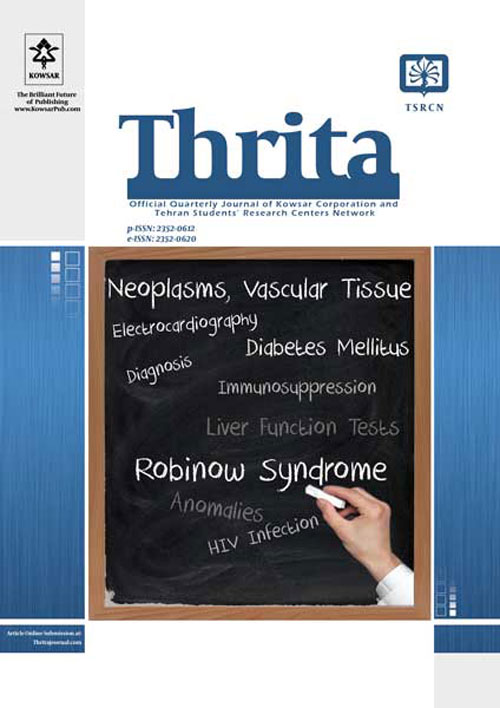فهرست مطالب

Thrita
Volume:7 Issue: 21, Jun 2018
- تاریخ انتشار: 1396/07/30
- تعداد عناوین: 4
-
-
Page 1IntroductionEndodontic treatment is done to eliminate the potential sources of infection from the root canal space. Having extensive knowledge of the exact of internal anatomy of root canals is a prerequisite for a successful endodontic treatment. It is abnormal to have a second palatal root in a maxillary second molar; however, accurate diagnosis could provide a suitable treatment.Case PresentationThe current study reports on a 20-year-old female with a maxillary second molar with two palatal roots. Using the cold lateral compaction technique, the canals were filled with gutta-percha and AH26 sealer. Additionally, a detail description of the treatment and its management is provided in this report.ConclusionsOn the third month of follow-up, all signs had disappeared and the patient showed no sign of periodontal ligament space widening.Keywords: Maxillary, Second Molar, Palatal Root, Case Report
-
Page 2IntroductionPulp necrosis is a common consequence of extrusive luxation in mature teeth with complete apical closure. In this report, the researchers presented a case with severely extruded mature mandibular incisors (more than 5 mm), which did not lead to pulp necrosis.Case PresentationThe case was a nine-year-old female with severe dentoalveolar trauma to the anterior maxillary and mandibular region, as a result of a bicycle accident. The treatment consisted of mandibular alveolar bone and central incisors repositioning. After 18 months of follow-up, no sign of pulp necrosis was observed.ConclusionsIn young patients with severe extrusive luxation and closed apices, there is the potential for pulp survival, and early endodontic treatment should be avoided until signs of pulp necrosis is observed.Keywords: Extrusion, Extrusive Luxation, Traumatic Injury, Mature Teeth
-
Page 3Different biomarkers and signaling pathways are involved in bone development. These factors lead to different osteoprogenitor cell reactions. Proliferation, migration, and differentiation of osteoprogenitor cells is induced by different intracellular and extracellular molecular signaling pathways. As mesenchymal stem cells (MSCs) and their differentiation during repair and development of bone processes have significant roles, it is believed that sensible molecular signaling pathways involvement is vital to the development of bone formation, bone substitute materials, and bone repair. This study reviews various keys of signaling pathway that terminate proliferation, migration, and differentiation of osteoprogenitor cells.Keywords: Bone, Signaling Pathways, Osteoprogenitor, Proliferation, Differentiation
-
Page 4Leiomyosarcoma is an aggressive type of soft tissue neoplasm that originates from smooth muscle cells; it is typically found in the uterus, gastrointestinal tract, and retroperitoneum. Primary leiomyosarcoma of bone is an extremely rare phenomenon first reported in 1965. Here, we present a case of primary leiomyosarcoma of bone occurred in the proximal humerus of a 41-year-old man who was referred to our orthopaedic clinic with a chief complaint of persistent left shoulder pain. Radiological investigations revealed a proximal lesion of the left humerus with periosteal reaction. Core needle biopsy of the lesion was performed later, which pointed to primary leiomyosarcoma of bone as the underlying pathology. Subsequently, complete resection of the lesion and prosthetic replacement of the proximal humorous were performed. The patient was followed three months after the surgery, and no sign of local recurrence or metastatic lesion was detected. To the best of our knowledge, this is the first case report of primary leiomyosarcoma of bone in Iran.

